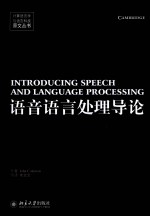

语音语言处理导论PDF电子书下载
- 电子书积分:12 积分如何计算积分?
- 作 者:(英)克勒曼著
- 出 版 社:北京市:北京大学出版社
- 出版年份:2010
- ISBN:9787301171530
- 页数:301 页
1 Introduction 1
1.1 About this book 2
1.2 Purpose of this book 2
1.3 Some reasons to use this book 3
1.4 What's in the book(and what's not) 5
1.5 Computational set-up needed for this book 8
1.6 Computational skills that are necessary in order to use the book 9
1.7 Free software suggestions 10
1.8 Book structure 10
2 Sounds and numbers 13
2.1 Preparatory assignments 14
2.2 Solutions 21
2.3 Sampling 24
2.4 Quantization 24
2.5 The sampling theorem 27
2.6 Generating a signal 29
2.7 Numeric data types 31
2.8 The program 34
2.9 Structure of a loop 35
2.10 Structure of an array 37
2.11 Calculating the cosine values 38
2.12 Structure of the program 39
2.13 Writing the signal to a file 40
Chapter summary 43
Further Exercises 43
Further reading 46
3 Digital filters and resonators 47
3.1 Operations on sequences of numbers 48
3.2 A program for calculating RMS amplitude 48
3.3 Filtering 50
3.4 A program for calculating running means of 4 52
3.5 Smoothing over a longer time-window 54
3.6 Avoiding the need for long window 54
3.7 IIR filters in C 61
3.8 Structure of the Klatt formant synthesizer 62
Chapter summary 68
Exercises 68
Further reading 69
4 Frequency analysis and linear predictive coding 71
4.1 Spectral analysis 72
4.2 Spectral analysis in C 72
4.3 Cepstral analysis 79
4.4 Computation of the cepstrum in C 80
4.5 Pitch tracking using cepstral analysis 83
4.6 Voicing detection 86
4.7 f0 estimation by the autocorrelation method 90
4.8 Linear predictive coding 95
4.9 C programs for LPC analysis and resynthesis 100
4.10 Trying it out 106
4.11 Applications of LPC 106
Chapter Summary 109
Further exercises 109
Further reading 110
5 Finite-state machines 111
5.1 Some simple examples 112
5.2 A more serious example 113
5.3 Deterministic and non-deterministic automata 116
5.4 Implementation in Prolog 118
5.5 Prolog's processing strategy and the treatment of variables 129
5.6 Generating strings 132
5.7 Three possibly useful applications of that idea 134
5.8 Another approach to describing finite-state machines 135
5.9 Self-loops 137
5.10 Finite-state transducers(FSTs) 139
5.11 Using finite-state transducers to relate speech to phonemes 144
5.12 Finite-state phonology 149
5.13 Finite-state syntactic processing 153
Chapter summary 156
Further exercises 156
Further reading 156
6 Introduction to speech recognition techniques 157
6.1 Architectures for speech recognition 158
6.2 The pattern-recognition approach 166
6.3 Dynamic time warping 168
6.4 Applications 177
6.5 Sources of variability in speech 181
Chapter summary 182
Further reading 183
7 Probabilistic finite-state models 185
7.1 Introduction 186
7.2 Indeterminacy:n-gram models for part-of-speech tagging 187
7.3 Some probability theory for language modelling 190
7.4 Markov models 192
7.5 Trigram models 198
7.6 Incompleteness of the training corpus 202
7.7 Part-of-speech model calculations 209
7.8 Using HMMs for speech recognition 210
7.9 Chomsky's objections to Markov models and some rejoinders 213
Chapter summary 219
Further reading 219
8 Parsing 221
8.1 Introduction 222
8.2 A demo 222
8.3 'Intuitive'parsing 223
8.4 Recursive descent parsing 225
8.5 The simplest parsing program 232
8.6 Difference lists 233
8.7 Generating a parse tree 236
8.8 Syllabification 238
8.9 Other parsing algorithms 242
8.10 Chart parsing 242
8.11 Depth-first vs.breadth-first search 245
8.12 Deterministic parsing,Marcus parsing and minimal commitment parsing 246
8.13 Parallel parsing 249
Chapter summary 249
Further reading 250
9 Using probabilistic grammars 251
9.1 Motivations 252
9.2 Probabilistic context-free grammars 256
9.3 Estimation of rule probabilities 258
9.4 A practical example 261
9.5 A limitation of probabilistic context-free grammars 267
9.6 Tree adjoining grammars 268
9.7 Data-oriented parsing 271
Chapter Summary 272
Conclusion and suggestions for further reading 272
Appendix:The American Standard Code for Information Interchange(ASCII) 275
Glossary 277
References 293
Index 299
- 《物联网导论》张翼英主编 2020
- 《程序逻辑及C语言编程》卢卫中,杨丽芳主编 2019
- 《大数据Hadoop 3.X分布式处理实战》吴章勇,杨强 2020
- 《材料导论》张会主编 2019
- 《化工传递过程导论 第2版》阎建民,刘辉 2020
- 《幼儿园课程资源丛书 幼儿园语言教育资源》周兢编 2015
- 《高等学校“十三五”规划教材 C语言程序设计》翟玉峰责任编辑;(中国)李聪,曾志华,江伟 2019
- 《音乐语言的根基》张艺编著 2019
- 《认知语言学视野的抽象方位结构研究》曹爽著 2019
- 《激活语言思维》李蒨,王宏年,汤青编著 2017
- 《古代巴比伦》(英)莱昂纳德·W.金著 2019
- 《BBC人体如何工作》(英)爱丽丝.罗伯茨 2019
- 《一个数学家的辩白》(英)哈代(G.H.Hardy)著;李文林,戴宗铎,高嵘译 2019
- 《莎士比亚全集 2》(英)莎士比亚著,朱生豪等译 2002
- 《莎士比亚戏剧精选集》(英)威廉·莎士比亚(William Shakespeare)著 2020
- 《莎士比亚 叙事诗·抒情诗·戏剧》(英)威廉·莎士比亚著 2019
- 《亚历山大继业者战争 上 将领与战役》(英)鲍勃·本尼特,(英)麦克·罗伯茨著;张晓媛译 2019
- 《孩子们的音乐之旅 1 宝宝睡觉 幼儿版》包菊英主编 2016
- 《超级参与者》王金强责编;赵磊译者;(澳)杰里米·海曼斯,(英)亨利·蒂姆斯 2020
- 《物联网导论》张翼英主编 2020
- 《大学计算机实验指导及习题解答》曹成志,宋长龙 2019
- 《指向核心素养 北京十一学校名师教学设计 英语 七年级 上 配人教版》周志英总主编 2019
- 《大学生心理健康与人生发展》王琳责任编辑;(中国)肖宇 2019
- 《大学英语四级考试全真试题 标准模拟 四级》汪开虎主编 2012
- 《大学英语教学的跨文化交际视角研究与创新发展》许丽云,刘枫,尚利明著 2020
- 《北京生态环境保护》《北京环境保护丛书》编委会编著 2018
- 《复旦大学新闻学院教授学术丛书 新闻实务随想录》刘海贵 2019
- 《大学英语综合教程 1》王佃春,骆敏主编 2015
- 《大学物理简明教程 下 第2版》施卫主编 2020
- 《指向核心素养 北京十一学校名师教学设计 英语 九年级 上 配人教版》周志英总主编 2019
